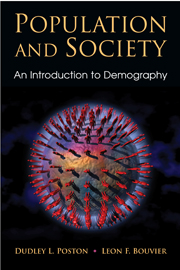Book contents
- Frontmatter
- Contents
- Preface
- Introduction
- 1 “We Are All Population Actors”: An Introduction to Demography
- 2 The Sources of Demographic Information
- 3 Fertility
- 4 Contraception and Birth Control
- 5 Mortality
- 6 Internal Migration
- 7 International Migration
- 8 Age and Sex Composition
- 9 World Population Change over Time
- 10 Population Change in the United States
- 11 Population Distribution
- 12 Cultural Adaptation and Growth
- 13 Population Policy
- 14 The Future of Planet Earth
- Glossary
- References
- Author Index
- Subject Index
6 - Internal Migration
- Frontmatter
- Contents
- Preface
- Introduction
- 1 “We Are All Population Actors”: An Introduction to Demography
- 2 The Sources of Demographic Information
- 3 Fertility
- 4 Contraception and Birth Control
- 5 Mortality
- 6 Internal Migration
- 7 International Migration
- 8 Age and Sex Composition
- 9 World Population Change over Time
- 10 Population Change in the United States
- 11 Population Distribution
- 12 Cultural Adaptation and Growth
- 13 Population Policy
- 14 The Future of Planet Earth
- Glossary
- References
- Author Index
- Subject Index
Summary
INTRODUCTION
In previous chapters, we discussed two of the three ways that populations change their size by adding or subtracting members. People are added to a population through births and are taken away through deaths. We now turn to the third and last way that populations change their size, namely, migration. Persons may be added to a population by moving into it or subtracted by moving away from it. Unlike birth and death, which occur to each of us once and only once, migration may occur on multiple occasions, or we may never experience migration.
There are two main types of migration, namely, within a country and between countries; the former is internal migration, and the latter, international migration. The dynamics of the two kinds of migration differ significantly, and many of their concepts and theories are also different. We will see that although their theories are more or less governed by “push” and “pull” factors, they differ in their emphasis and focus. In this chapter, we focus on internal migration; in Chapter 7, we cover international migration.
Internal migration is the change of permanent residence within a country, involving a geographical move that crosses a political boundary, usually a county or county-type geographical unit. Not all changes in residence are migrations, however. Indeed, demographers distinguish between “movers” and “migrants.” Any person who changes residence, whether the change involves moving across the street or from Maine to Hawaii, is a mover.
- Type
- Chapter
- Information
- Population and SocietyAn Introduction to Demography, pp. 166 - 195Publisher: Cambridge University PressPrint publication year: 2010



